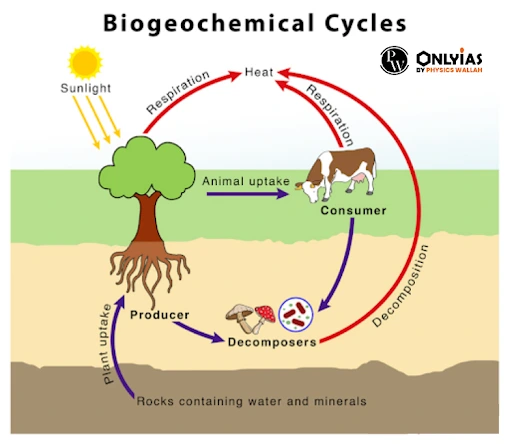|
Ecosystem: Components, Functions, Energy Flow & Cycle |
Ecosystem Harmony: Life in Defined Geographical Spheres
An ecosystem is a defined geographical area where plants, animals, and various organisms interact with the prevailing weather and landscape to create a self-contained sphere of life. The earth as a whole is a series of connected ecological systems where biotic and abiotic factors interact with each other to sustain life.
Ecosystem – The Dynamic Interplay of Life and Environment
- The term ecosystem was coined by Sir Arthur Tansley in 1935. It is a geographic area where plants, animals, and other organisms, as well as weather and landscapes, work together to form an envelope of life.
- Varied in size: It can be of any size however, usually has specific and limited species. E.g. Grassland Ecological system.
- Functional unit: It is a functional unit of nature which consists of complex interaction between its biotic i.e., living and abiotic i.e., non-living components.
Component of Ecosystem: The building blocks of Biodiversity
- Ecosystems consist of various interconnected components majorly categorized into biotic and abiotic components.
- Biotic Components: These include all the living organisms within the ecological system, such as plants, animals, fungi, and microorganisms.
- These organisms interact through predation, competition, symbiosis, and other ecological relationships.
- Abiotic Components: The non-living factors in an ecological system, including the physical and chemical elements like temperature, climate, soil, water, and sunlight.
- These abiotic factors influence the distribution and behavior of biotic components.
Function of Ecosystem: The ecological functions- Sustaining life on Earth
- Ecosystems are complex dynamic systems. They perform certain functions:
- Energy flows through the food chain.
- Nutrient cycling (biogeochemical cycles).
- Ecological succession or ecosystem development.
- Homeostasis or feedback control mechanisms.
Energy Flow: Basis of Energy Cycle
- The movement of energy across various trophic levels in an ecological system is the basis of the energy cycle.
- Unidirectional Flow: Energy flows through the trophic levels from producers to subsequent trophic levels is unidirectional.
- Energy Decline: The loss of energy in the form of heat at each trophic level causes the energy level to decline from the first trophic level.
- Tropical Limitation: Each trophic level has a considerable amount of energy loss.
- So, typically, there are four to five trophic levels (beyond this the energy available is negligible to support an organism).
Nutrient Cycling: The ever-changing flow of life’s building blocks
- A biogeochemical cycle, also known as a nutrient cycle, is a pathway through which essential elements or nutrients are circulated in the environment.
- These cycles involve both biotic (living) and abiotic (non-living) components of ecological system and play a crucial role in maintaining the balance of nutrients required for life.
- Majorly biogeochemical cycles include the water cycle, carbon cycle, nitrogen cycle, phosphorus cycle and sulfur cycle.
- Decomposers break down dead organisms and organic matter, returning essential nutrients to the soil or water, where they can be used by producers.
Ecological Succession: The natural transition of Environment
- Ecosystems change over time through ecological succession, which can be primary succession (from bare land) or secondary succession ( formed after a disturbance).
- Succession describes how communities of organisms evolve and adapt within an ecological system.
Ecosystem Harmony: Homeostasis and Feedback Control Mechanisms
- In an ecological system, homeostasis refers to the ability of the system to self-regulate and maintain a balance among its biotic and abiotic components.
- Example: Climate Regulation: Forest ecological system, through the process of transpiration, can influence local climate and help regulate temperature and humidity.
- Nutrient Cycling: Nutrient cycles, such as the nitrogen cycle or carbon cycle, work to keep essential elements in balance within ecological systems.
- They can also exhibit a form of homeostasis in which they maintain a dynamic equilibrium or stability which is achieved through various feedback control mechanisms.
- Feedback Control Mechanisms: Positive and Negative Feedback Loops”
- Positive Feedback: This amplifies a change within the ecological system, potentially leading to destabilization.
- Example: Positive feedback loop of increased global temperatures causing more ice to melt, which, in turn, leads to more warming.
- Negative Feedback: This stabilizes the system and counters changes.
- Example: When a predator population increases, it may lead to a decrease in the prey population, which, in turn, reduces the predator population due to food scarcity.
- Positive Feedback: This amplifies a change within the ecological system, potentially leading to destabilization.
Ecosystem Services: Nature’s Vital Contributions to Life
- Ecosystems provide essential services for both the natural world and human society, including the regulation of climate, purification of water and air, and the provision of resources like food and medicine.
Understanding and conserving ecological systems is crucial for maintaining the health of our planet and ensuring the well-being of all species, including humans.
































